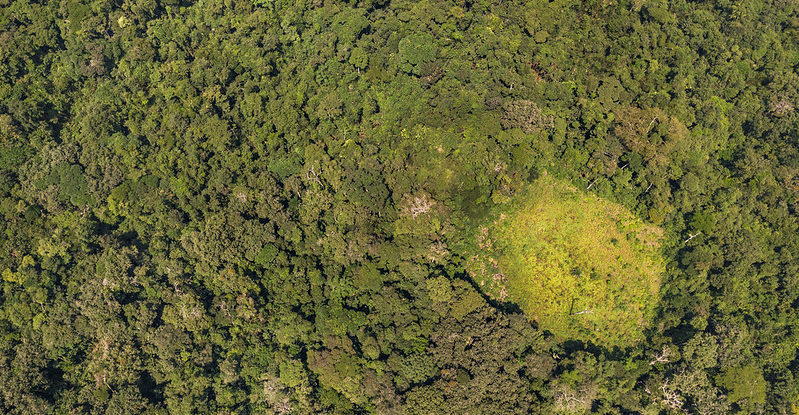
The Congo Basin is home to the second largest tropical forest in the world, but it is well behind Southeast Asia and the Amazon region in terms of attracting international funding for sustainable management and nature protection, according to an analysis of financial fluctuations between 2008 and 2017.
The Central African rainforest is a global public good. Boosting international support for this natural thermostat and haven of biodiversity requires better governance and capacities on the countries side, stronger coordination among funding agencies, and strategies to attract private investment.
Snapshot of financial flows
The Congo Basin captured 11.5 percent of international funding in the past decade, while Southeast Asia and the Amazon received 54.5 percent and 34 percent respectively, a new analysis by the Observatoire des forêts d’Afrique centrale (OFAC) of the Commission des forêts de l’Afrique centrale (COMIFAC) reveals.
Until now, consolidated figures on how public and private actors invest in the three major tropical forest basins in the world did not exist, which makes this snapshot of financial flows a critical first step in assessing the general state of affairs worldwide and charting the way forward.
The study shows that Central African forests received $2 billion from bilateral (52.5 percent) and multilateral (47.5 percent) sources, with Germany accounting for 25 percent of funding, followed by the European Union and the Global Environment Fund (GEF). Most funds went to Democratic Republic of Congo (40 percent), Chad (17 percent) and Cameroon (14 percent).
With regard to topics, funding concentrated on forest and environmental policy and management (41 percent), followed by biodiversity management and conservation (36.9 percent) and environmental research and education (13.8 percent).
The growing national and international demand for forest products, including timber and wood fuel, is one of the main drivers of forest loss in Central Africa. However, sustainable forestry development and the use of wood as a source of energy only captured 8.3 percent of the funding.
Loans versus grants
Capacity to carry debt, lower risk profile, major creditors and stronger diplomatic relations with donor countries could be some of the reasons Southeast Asia and the Amazon region attracts international finances more readily.
Take the bilateral and multilateral funders financing the forest-environment sector in Central Africa: most of them do it through grants, while they sometimes resort to loans for the countries in the other tropical basins. Southeast Asia, for example, received $885 million from the World Bank, mainly through loans.
In contrast, the Congo Basin did not have any forestry-related projects approved by the Green Climate Fund (GCF) until 2017, and the region only captured 7.6 percent of the funds bilateral donors earmarked for the forest-environment sector in the tropics.
A notable exception to this trend is the European Union, which prioritized Central Africa ($329 million) as compared to the Amazon Basin ($122 million) and the Southeast Asia Basin ($86.5).
Attracting international funding
Conserving and sustainably managing the Congo Basin is important from the perspective of livelihoods, biodiversity and regulation of climate and rain patterns, locally and globally. With so much at stake, it is in the global interest to preserve these forests and the services they provide.
Central African countries could start by improving governance in ODA management and reducing the perception of risk among private investors and donors. Private sector contributions have been very modest so far, but improving issues such as land tenure security and legal certainty could attract further investments.
One way this could occur, for example, is through timber certification, restoration of forest landscapes, and corporate environmental and social management plans as a way for companies to offset their carbon emissions.
Another crucial step is to strengthen the capacity of Central African professionals to formulate high quality project proposals, and to adequately manage initiatives in the forest-environment sector. Such capacities are essential to succeeding in competitive processes, for instance, vis-à-vis the Green Climate Fund.
International funding agencies could also support capacity-building and work together more closely to ensure an adequate coverage of projects across the tropics.
The analysis published by the OFAC offers a unique vantage point into the funding landscape for forest conservation and management in the tropics. Equipped with this newly acquired perspective, donors and recipient countries can jointly embark on the path to preserve the Congo Basin for present and future generations.
We want you to share Forests News content, which is licensed under Creative Commons Attribution-NonCommercial-ShareAlike 4.0 International (CC BY-NC-SA 4.0). This means you are free to redistribute our material for non-commercial purposes. All we ask is that you give Forests News appropriate credit and link to the original Forests News content, indicate if changes were made, and distribute your contributions under the same Creative Commons license. You must notify Forests News if you repost, reprint or reuse our materials by contacting forestsnews@cifor-icraf.org.